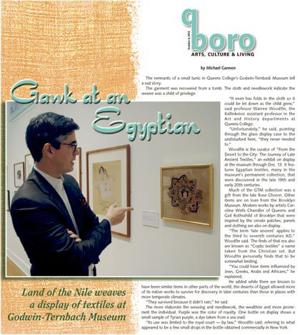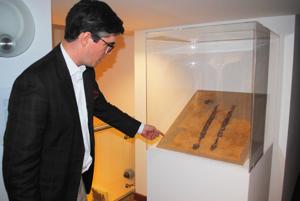Egyptian art and history out of whole cloth
Posted: Thursday, October 4, 2018 10:30 am
The remnants of a small tunic in Queens College's Godwin-Ternback Museum tell a sad story.
The garment was recovered from a tomb. The cloth and needlework indicate the wearer was a child of privilege.
"It even has folds in the cloth so it could be let down as the child grew," said professor Warren Woodfin, the Kallinkeion assistant professor in the Art and History departments at Queens College.
"Unfortunately," he said, pointing through the glass display case to the undisturbed hem, "they never needed to."
Woodfin is the curator of "From the Desert to the City: The Journey of Late Ancient Textiles," an exhibit on display at the museum through Dec. 13. It features Egyptian textiles, many in the museum's permanent collection, that were discovered in the late 19th and early 20th centuries.
Much of the GTM collection was a gift from the late Rose Choron. Other items are on loan from the Brooklyn Museum. Modern works by artists Caroline Wells Chandler of Queens and Gail Rothschild of Brooklyn that were inspired by the ornate patches, panels and clothing are also on display.
"The term 'late ancient' applies to the third to seventh centuries AD," Woodfin said. The finds of that era also are known as "Coptic textiles" a name taken from the Christian set. But Woodfin personally finds that to be somewhat limiting.
"You could have items influenced by Jews, Greeks, Arabs and Africans," he explained.
He added while there are known to have been similar items in other parts of the world, the deserts of Egypt allowed more of its native works to survive for discovery in later centuries than those in places with more temperate climates.
"They survived because it didn't rain," he said.
The more elaborate the weaving and needlework, the wealthier and more prominent the individual. Purple was the color of royalty. One bottle on display shows a small sample of Tyrian purple, a dye taken from a sea snail.
"Its use was limited to the royal court — by law," Woodfin said, referring to what appeared to be a few small drops in the bottle obtained commercially in New York.
"This is about $100 for less than 1/8 of a teaspoon," he said. But some in ancient times found ways around the royal decrees, creating dyes of their own from indigo and other materials much easier to come across.
Two ancient cloth sleeve bands show imagination as well as loom craft. Looking one way, they depict a scene of sea nymphs swimming. Look from a different angle and dancers appear.
"It just depends on what direction you hold your arms in," the professor said.
Another piece, believed to be a patch from an elaborate tunic or other outfit, is made of linen with various colors of wool. The woman depicted in the central portrait has a bug-eyed stare that Woodfin said could indicate it was used to ward off an ancient Egyptian incarnation of the evil eye.
"If you were wealthy, people might give you the evil eye," he said.
The patch is believed to have originated between the fourth and seventh centuries, though Woodfin said this has a visible, if unexplained, history. First, the circular portrait was sewn into the elaborately detailed cloth square after the original center somehow went missing over the centuries. Faces of figures in the original square were scratched or cut out long ago.
Still another strip of cloth, titled "Purple Band with Bacchic Dancer," celebrates the common theme of some long-ago grape harvest. Just a few inches long, it has been reproduced as a large painting by Rothschild, complete with worn, torn, frayed fibers corresponding exactly to the original.
But the dancer is depicted as hermaphroditic, with both breasts and male genitalia, also not uncommon for the time.
"Even then people had questions about sexual identity," Woodfin quipped. "Nothing is new."
The exhibit opened on Sept. 13. Woodfin said he has been pleased with the turnout — a successful opening reception was just the start.
"The other day I saw some students in here and asked if they were from an art class," he said. "I was told they were students who just wanted to see the exhibit."
-- Sent from my Linux system.


No comments:
Post a Comment